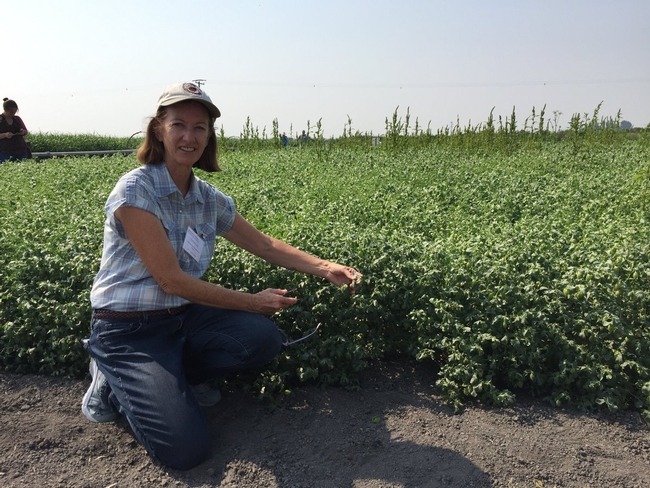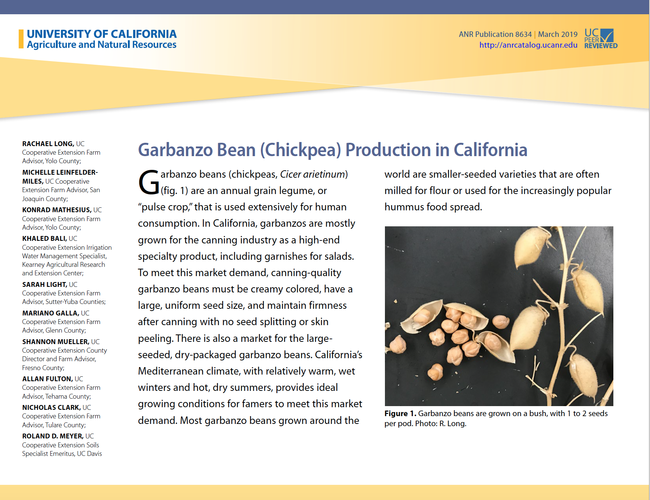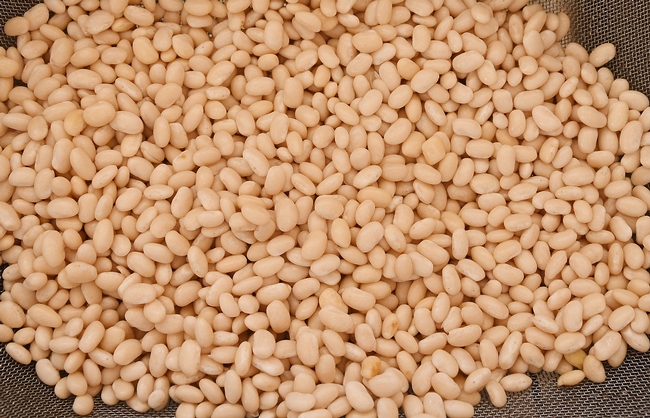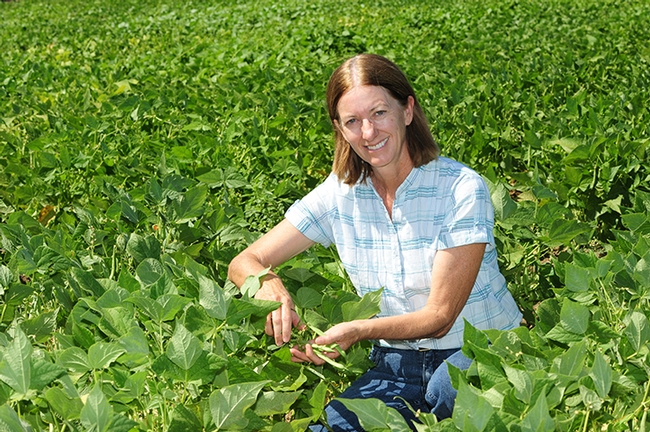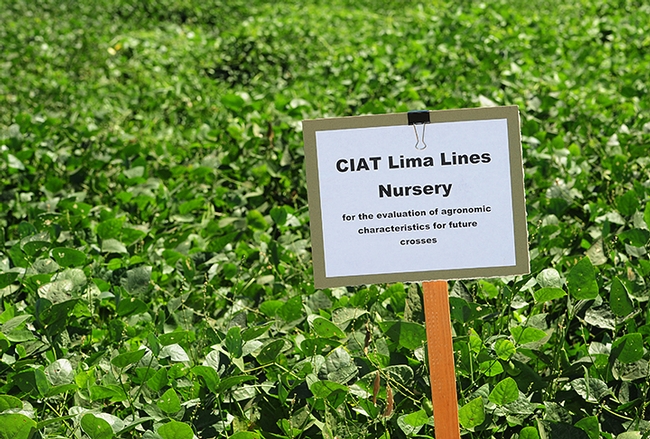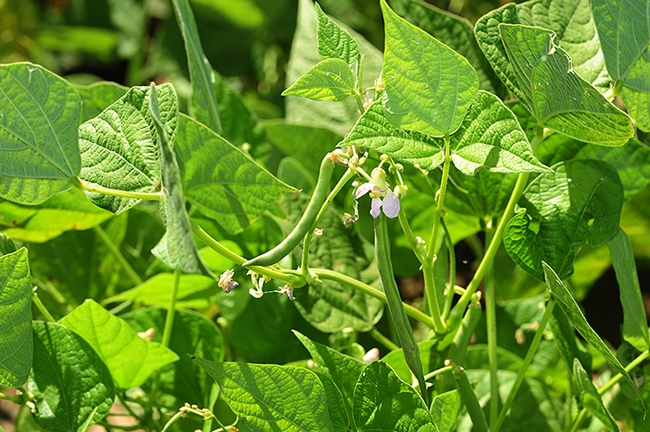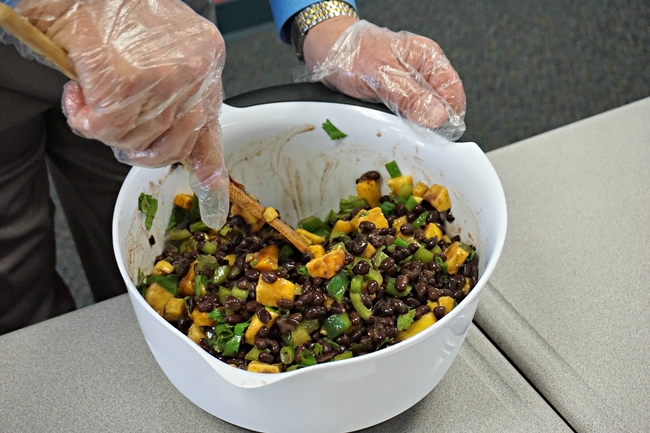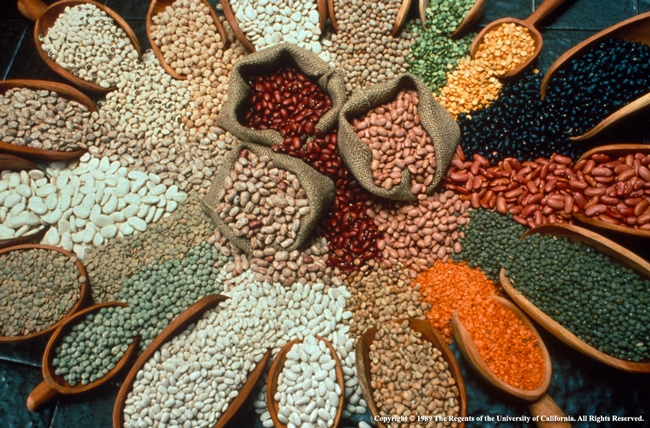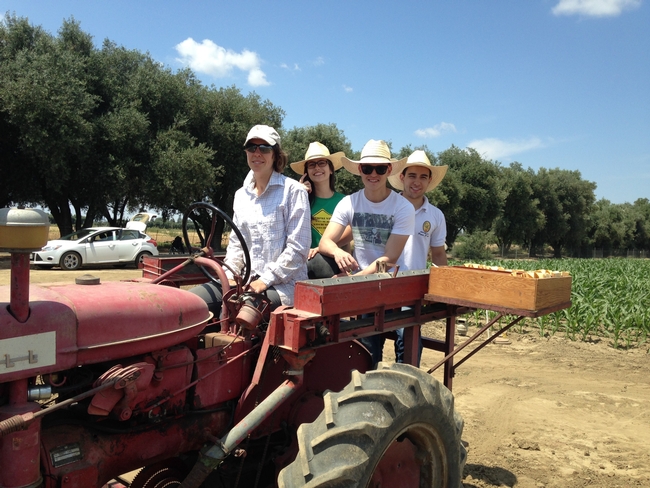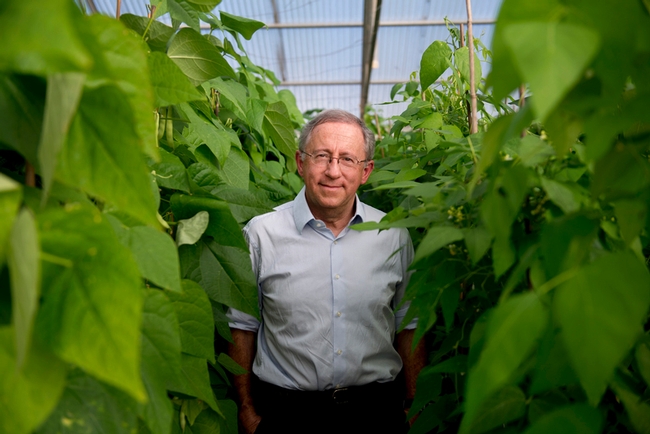Posts Tagged: beans
Garbanzo bean production guide published for small but thriving industry
Try topping your salads with some tasty garbanzo beans this summer. Not only are they a healthful source of protein, vitamins and minerals, but the ‘green' legumes are produced in California with a small environmental footprint!
California farmers grow about 10,000 acres of garbanzo beans, mostly for the canning market.
“We have the right growing conditions, including cool, wet winters and hot, dry summers, to produce high-quality, large, creamy-white garbanzo beans for high-end markets, like salad bars,” says Rachael Long, UC Cooperative Extension farm advisor for Sacramento, Solano and Yolo counties. “Other areas, such as Washington State, grow a smaller garbanzo bean destined for processing, like hummus, a creamy vegetable spread.”
Garbanzos, also called chickpeas, are originally from the Middle East, where they have been farmed since ancient times. In California, their heritage dates back to the Spanish Mission era. California garbanzo beans are grown in the winter time, minimizing water use. The nitrogen-fixing legumes supply their own nitrogen and require few pesticides for production as the plants secrete acids that ward off insect pests.
To assist farmers in production practices, Long led a team of researchers to produce a new 2019 Garbanzo (chickpea) production manual for the dry bean industry in California.
“This is a great resource for farmers and the industry,” says Nathan Sano, manager for the California Dry Bean Advisory Board, about the publication, which covers garbanzo production from seed selection to harvesting and markets.
The manual identifies garbanzo varieties that have pest and disease resistance. Nutrient management information helps growers comply with regulations for protecting groundwater from nitrate. The irrigation section provides tables on water needs for crops grown in different areas of California, helping to conserve water.
“Our UC ANR Grain-Legume workgroup started this production manual back in 1992,” Long said. “I'm thankful for a strong team and grower and industry input and support. I also appreciate the incredible mentoring and reviews of this manual by Roland Meyer, UC Cooperative Extension emeritus soil specialist, and a fantastic editor, UC Cooperative Extension agronomy specialist Dan Putnam, to make this publication a reality. This was a big group effort, and I appreciate everyone's contributions to make this a valuable resource for the California dry bean industry.”
The California garbanzo bean production manual is available for free online at https://anrcatalog.ucanr.edu/Details.aspx?itemNo=8634.
In addition to Long and Meyer, co-authors include UC Cooperative Extension farm advisors Michelle Leinfelder-Miles, Konrad Mathesius, Sarah Light, Mariano Galla, Shannon Mueller, Allan Fulton and Nick Clark, and UC Cooperative Extension irrigation specialist Khaled Bali.
'Know beans' about a delicious Thanksgiving
Beans are one of civilization's earliest cultivated crops, dating back to the early seventh millennium BCE. Today there are more than 40,000 varieties of beans worldwide.
Beans can also have a place on the Thanksgiving table. The Maple Spice blog for vegans shares a meat-free substitute for turkey that combines mashed white canelli beans, nutritional yeast, vital wheat gluten and spices to create a loaf that slices like turkey breast. UC CalFresh, one of the UC Agriculture and Natural Resources' nutrition education programs, developed a recipe for black bean and mango salad that makes a healthful and colorful accompaniment to a traditional Thanksgiving meal. (The recipe is below.)
"Not only are beans a healthy food choice, but they are also a healthy choice for our world," said UC Cooperative Extension advisor and dry bean expert Rachael Freeman Long. "Beans fix most of their own nitrogen so require fewer inputs for production compared to other sources of protein and they're cheap! Plus some, like garbanzos, are grown during the wintertime, so they're less dependent on irrigation."
The different varieties of beans include garbanzos (chickpeas) as well as black eyes, limas, and common beans like pintos and kidneys.
You probably won't find a bigger fan of beans than Rachael Long. "I eat them at least once a week or more," she said. "I love going on our Cal Beans website and getting new recipes. Summer time, I love beans on my salad, especially garbanzos. At this time of year, I love soups with beans. My favorite is the kale white bean sausage soup. If I want to go vegetarian, I'll leave out the sausage or sometimes fry up some tofu sausage for flavor. And, it just so happens that this is the soup in the current bean blog. I got the original recipe from one of our nutrition staff at our office."
Long says that Cal Beans is an important site for bean growers and industry folks, too. "It's supported by the California Dry Bean Advisory Board, an important funding source for my work. Right now, I have a grant to look at seed moisture and quality at harvest (possibly drying down seed too much at harvest results in internal injury to planting beans (seed stock)."
What do you know about beans? Do you know that California grows the canning quality beans?
"We have the perfect weather conditions for those large, creamy beige-colored beans," Long said. "Other states like Washington grow about 100,000 acres of garbanzos for humus (but a lower quality bean and we can't compete with their free water via rainfall."
California farmers supply virtually all of our country's dry lima beans, Long notes. In 2012, California farmers grew about 23,000 acres of baby and large limas, valued at $30 million that year, according to the National Agricultural Statistics Service.
Long has authored two UC ANR manuals about beans (Lima Bean Production in California and Common Dry Bean Production Manual) and is just finishing the garbanzo production manual (it's in peer review).
"Lima beans are a major dry bean crop for California, representing a significant portion of the total dry bean acreage in 2013," she wrote in the Lima Bean Production in California. "Lima beans are primarily grown for the dried edible white bean in California, although a limited but stable acreage is also for seed production. As with all dry beans, limas are a nutritional and healthy food choice, being an excellent source of protein, fiber, vitamins, and minerals. Lima beans are also an important rotation crop for farmers because the plants fix nitrogen, add biomass to the soil, and require relatively few pesticides."
Lima beans belong to the species Phaseolus lunatus, distinct from the common bean, P. vulgaris.
"Common dry beans include the market classes kidney, cranberry, pink, black, white, yellow, pinto, and red, all of which are different types of a single species (Phaseolus vulgaris) that was originally domesticated several thousand years ago in the areas that are now Mexico and South America," Long wrote in the Common Dry Bean Production Manual. "Natural selection and breeding programs lead eventually to the current market classes, which are mainly distinguished by seed size, color, and shape, and plant growth habit. Currently, there are no commercially available genetically modified varieties of P. vulgaris."
"Dry beans," Long points out, "are grown in California mainly for human consumption, though a limited but stable acreage is dedicated to seed production. Dry beans are nutritious: they are high in starch, protein, and dietary fiber, they have no cholesterol, and they are an excellent source of iron, potassium, selenium, molybdenum, thiamine, vitamin B6, and folic acid. The U.S. Department of Agriculture considers dry beans to be both a vegetable and a protein source."
Rosane Oliveira, director of the UC Davis Integrative Medicine Program and an adjunct assistant professor in the UC Davis School of Medicine's Department of Health Sciences, recently praised beans as one of the "Fab 4" plant foods in her "21-Day Food Challenge" blog.
Beans are brilliant, Oliveira says, because they:
Indeed, there's even a National Bean Day, observed annually on Jan. 6. Want to know more about beans? You'll find a wealth of information about dry beans from the U.S. Dry Bean Council.
Bottom line: Beans should be an important part of your diet. You can call them "nutritious," you can call them "delicious," or you can call them "brilliant." They're all three.
UC CalFresh mango and black bean salad
Ingredients:
- 1 15-ounce can black beans, rinsed and drained
- 2 cups peeled, pitted and diced fresh mango (about 2 small mangos)
- 1/4 cup sliced green onions
- 1/4 cup chopped bell pepper
- 2 tablespoons lime juice
- 2 tablespoons 100% orange juice
- 1 tablespoon chopped fresh cilantro
- 1/2 teaspoon chili powder
- 1/4 teaspoon ground cumin
Mix together all ingredients in a large bowl. Salad may be served right away, but is best if covered and chilled for a least 1 hour for flavors to blend.
Why we need a finger on the pulse of these California crops
Do you have your “finger on the pulse” of foods that pack a powerful nutritious punch and trending globally? Then you may know that the United Nations has declared 2016 as The International Year of Pulses. But you may not know what pulses are or California's role in the pulse industry.
Pulses are leguminous crops harvested solely for the dry seed. They include dried beans, lentils, and peas – those staple, nutritious and humble foods that our ancestors began cultivating more than 10,000 years ago.
The United Nations strives to raise awareness about pulses through its slogan, “Nutritious Seeds for a Sustainable Future.” The goals: to draw attention to the protein power and health benefits of pulses, to encourage global food-chain connections to better utilize pulses, to boost the global production of pulses, to better utilize crop rotations, and to address the challenges in the trade of pulses.
In California, farmers, the dry bean industry, and UC Agriculture and Natural Resources (UC ANR) researchers are doing their part with research and outreach programs that focus on dry bean production. Our state produces four classes of dry beans, including garbanzos (chickpeas), limas (baby and large), blackeyes (cowpeas), and common beans (such as kidney and cranberry) planted on a total of 50,000 acres and valued at about $70 million.
While not a big economic force like some crops, beans are nonetheless very important to our farming industry. They are needed in crop rotations to help control weeds and they improve soil health by adding biomass back into the soil after harvest and by fixing nitrogen. As such, pulses can contribute to climate change mitigation by reducing dependence on synthetic nitrogen fertilizers. Beans also are an important part of our food security. For example, California lima growers produce virtually all of our nation's dry limas, as well as 60 to 80 percent of the world's market.
Current UC ANR research focuses on improving integrated pest management of dry beans with minimal impacts to the environment. This includes collaborative studies with UC Davis and UC Riverside scientists to breed pest and disease resistant dry bean varieties that have both high yields and quality. Two new releases of garbanzo beans are expected this year. Additional projects focus on drought and heat tolerance in our warming world.
The new UC ANR Agronomy Research and Information Center website features the many agronomic crops grown in California, including beans. Resources available include current research work, cost of production studies, crop production guidelines, and a database of research supported by the California Dry Bean Advisory Board that goes back more than three decades. Stay tuned for additional resources, including online fertilization guidelines for dry beans, to help develop Farm Nutrient Management Plans, as well as the 2016 Integrated Pest Management (UC IPM) Guidelines for Dry Beans. (Click here for the current IPM guidelines)
Meanwhile, let us all join forces with the United Nations, UC ANR, and our state's Dry Bean Industry to raise the awareness of the benefits of pulses for a more sustainable world. This starts with adding more beans to our diet. Beans are packed with nutrients. They are high in protein, low in fat, and rich in fiber. They can lower cholesterol and help in the control of blood sugar and in managing diseases like diabetes, heart conditions and obesity.
Experiment. Prepare bean burritos often, use a variety of beans in your favorite chili recipe, try humus as a delicious vegetable dip, and garnish your salad with beans. The California Dry Bean Advisory Board website provides terrific bean recipes at http://www.calbeans.org. This we know: beans are pulses vital to our diets, just as our pulse rate is vital to monitoring our health.
Nothing common about these beans
As you're ladling up country-style pinto beans for your weekend barbecue or fixing a cold three-bean salad from kidney, string and navy beans for a summer picnic, pause to remember what a long and storied history these “common bean” varieties share and the new scientific advances that promise to boost their productivity worldwide.
This week, a new genome sequencing is being reported for the common bean, which ranks as the world's 10th most widely grown food crop and includes the culinary favorites above, whose varieties together comprise a $1.2 billion crop in the United States.
“The availability of this new whole-genome sequence for beans is already paying off,” said Paul Gepts, professor in the Department of Plant Sciences at UC Davis and co-author of the new sequencing study.
Gepts, who leads the bean-breeding program at UC Davis, notes that the new sequence is being used to confirm many of the findings made earlier by his UC Davis research group, including identification of the common bean's two points of origin and domestication.
Sequencing and bean ancestry
The common bean is thought to have originated in Mexico more than 100,000 years ago, but -- as the Gepts group earlier discovered – was domesticated separately at two different geographic locations in Mesoamerica and the southern Andes.
“This finding makes the common bean an unusually interesting experimental system because the domestication process has been replicated in this crop,” Gepts said.
The sequencing team compared gene sequences from pooled populations of plants representing these two regions and found that only a small fraction of the genes are shared between common bean species from the two locations. This supports the earlier finding that the common bean was domesticated in two separate events -- one at each location -- but distinct genes were involved in each event.
The new whole-genome sequencing is also helping to identify genetic “markers” that can be used to speed up breeding of new and more productive bean varieties in the United States, East Africa and elsewhere, Gepts said.
The nitrogen connection
All of bean varieties that belong to the “common bean” group share with the closely related soybean the highly valued ability to form symbiotic relationships with “nitrogen-fixing” bacteria in the soil.
The plants and the bacteria work together to convert nitrogen in the atmosphere into ammonia – which includes nitrogen in a form that enriches the soil and feeds crops. Nitrogen-fixing crop plants can actually reduce or eliminate the need for farmers to apply expensive fertilizers.
One goal of the new sequencing project was to better understand the genetic basis for how such symbiotic relationships between nitrogen-fixing plants and bacteria are formed and sustained, with an eye toward increasing fuel- and food-crop productivity.
The research team successfully identified a handful of genes involved with moving nitrogen around, which could be helpful to farmers who intercrop beans with other crops that don't fix nitrogen.
Findings from this study are reported this week online in the journal Nature Genetics. The sequencing project was led by researchers at the University of Georgia, U.S. Department of Energy Joint Genome Institute, Hudson Alpha Institute for Biotechnology and North Dakota State University.
Survey identifies 19 produce candidates for a farm-to-WIC program
A new federal voucher that gives low-income women access to a range of fruits and vegetables could provide unique new marketing opportunities for California growers.
In 2009, the federal Special Supplemental Nutrition Program for Women, Infants and Children (WIC) began distributing monthly cash vouchers to low-income women with children to buy fruits and vegetables. The program reaches almost half of the infants and one-quarter of children under 5 years old in the United States.
A team of UC Cooperative Extension (UCCE) researchers and nutrition advisors has been exploring the possibility of developing a farm-to-WIC program that would link these low-income consumers with local growers. The purpose of such a program would be to increase the consumption of a wide variety of fresh produce, with a focus on locally grown produce when available.
UCCE conducted a survey of produce preferences and buying habits among WIC participants in Tulare, Alameda and Riverside counties in 2010. The full study is published in the January-March 2012 issue of California Agriculture journal.
Based on the results, the UCCE team developed a list of 19 produce items to promote in a possible new farm-to-WIC program. They are:
|
|
|
Although mustard greens and collards were not popular across all sites, the advisors gauged a potential market in Alameda County, so these were retained. Based on write-in responses, oranges were also added.
In California, which has the nation's largest WIC program, 82 local agencies serve about 1.43 million participants at 623 local centers, and WIC participants can redeem their monthly vouchers at 4,000 grocery stores statewide. About 40 percent shop at WIC-only stores, which stock and sell only WIC-authorized foods.
Stocking produce is relatively new to WIC-only stores; before rollout of new WIC food packages in October 2009, these stores were only required to stock limited amounts of fresh carrots. In the survey, most WIC participants (58 percent to 72.3 percent) responded that their preferred stores offered many choices, but fewer participants (18.5 percent to 41 percent) rated the produce quality as “excellent.” Key factors determining purchase decisions were produce quality and freshness, and nutrient value (vitamins and minerals). Cost was relatively less important, possibly because WIC participants procure the produce with the vouchers.
The list has served as a starting point for discussions with growers and WIC vendors.
“The survey showed that WIC participants were interested in purchasing fresh produce with better quality and more variety,” wrote lead author Lucia L. Kaiser, Cooperative Extension specialist in the UC Davis Department of Nutrition, and co-authors, in California Agriculture. “Some WIC participants that we surveyed said they avoided shopping at WIC-only stores in part because these interests were not met.”
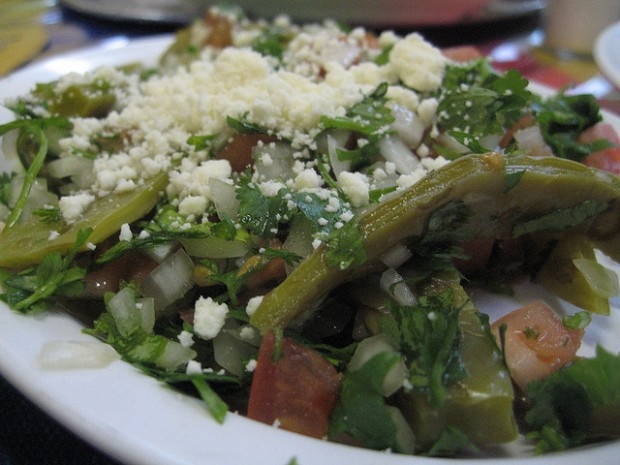
A dish made with nopales (cactus pads).


